- Experts
- Election 2024
-
Topics
FeaturedInternational efforts, such as the Paris Agreement, aim to reduce greenhouse gas emissions. But experts say countries aren’t doing enough to limit dangerous global warming.
-
Regions
FeaturedIntroduction Throughout its decades of independence, Myanmar has struggled with military rule, civil war, poor governance, and widespread poverty. A military coup in February 2021 dashed hopes for…
Backgrounder by Lindsay Maizland January 31, 2022
-
Explainers
FeaturedDuring the 2020 presidential campaign, Joe Biden promised that his administration would make a “historic effort” to reduce long-running racial inequities in health. Tobacco use—the leading cause of p…
Interactive by Olivia Angelino, Thomas J. Bollyky, Elle Ruggiero and Isabella Turilli February 1, 2023 Global Health Program
-
Research & Analysis
FeaturedThe rapidly changing landscape of foreign influence demands a new approach, argues Senior Fellow for Global Governance Miles Kahler. Countering malign influence from abroad will require a stronger democracy at home.
Council Special Report by Miles Kahler October 23, 2024 Diamonstein-Spielvogel Project on the Future of Democracy
-
Communities
Featured
Webinar with Carolyn Kissane and Irina A. Faskianos April 12, 2023
-
Events
FeaturedThis symposium was created to address the broad spectrum of issues affecting Wall Street and international economics. It was established through the generous support of Council board member Stephen C…
Virtual Event with Emily J. Blanchard, Matthew P. Goodman, David R. Malpass, Elizabeth Rosenberg, Janet Yellen, Michael Froman and Rebecca Patterson October 17, 2024 Greenberg Center for Geoeconomic Studies
- Related Sites
- More
China’s Maritime Disputes
Disputes between China and its neighbors, including the Philippines and Vietnam, in the South China Sea have intensified in recent decades, while the territorial row with Japan over the Senkaku/Diaoyu Islands in the East China Sea dates to the nineteenth century.






Sino-Japanese War Ends
The Sino-Japanese war, fought primarily over control of Korea, ends with the signing of the Treaty of Shimonoseki, in which China cedes territories including Formosa (Taiwan) to Japan. The treaty does not mention the Senkaku/Diaoyu Islands [PDF], which were not discussed during negotiations. Beijing maintains that this transfer included the islands, while Tokyo claims that it had owned them since January 1895, when it officially annexed the uninhabited land. This distinction comes into play after World War II, when China says the islands must be returned to Chinese rule as a result of the Cairo and Potsdam declarations, which oblige Japan to renounce claims to all territories seized through war.
Japan Invades South China Sea Islands
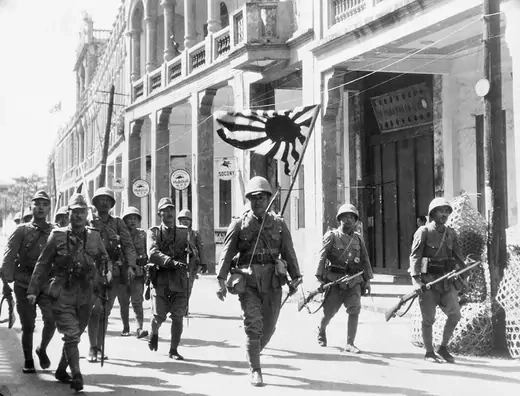
After claiming exclusive rights over several South China Sea archipelagos, Japan occupies the Pratas Islands. The Japanese Imperial Navy lands on the Spratlys in December 1938 and invades Hainan Island the following February. Japan’s moves follow the Marco Polo Bridge Incident of July 1937—a battle between the Republic of China’s National Revolutionary Army and the Japanese Imperial Army—which marks the Japanese invasion of China. Japan’s military foray into the South China Sea [PDF] takes place during a decade in which France’s Indochina forces have also been present in the area, surveying the islands in the early 1930s and occupying the Paracel Islands in 1938.
Senkaku/Diaoyu Islands Come Under U.S. Control
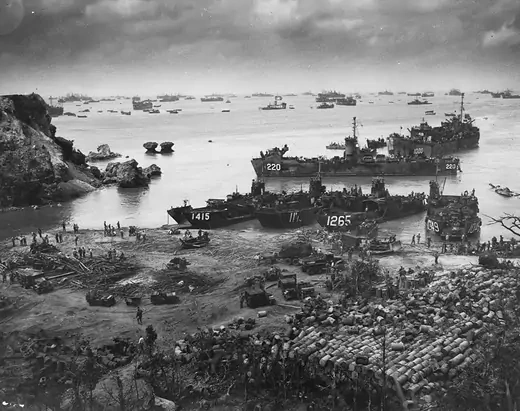
After Tokyo’s surrender at the end of World War II, the United States assumes control of Japan. This includes the Ryukyu Islands, which Washington later interprets to include the Senkaku/Diaoyu Islands. The greater Ryukyu Islands are seen as being of strategic significance at a time when communism is spreading in the region. The Kuomintang-led government of China makes repeated claims to the islands and in April 1948 calls for their return. The U.S. occupation of Japan’s main islands lasts until the end of the Korean War in 1952, but the United States continues to occupy Okinawa until 1972.
China Marks South China Sea Claims
China, under the rule of the nationalist Kuomintang party, demarcates its territorial claims in the South China Sea with an eleven-dash line on a map. The claim covers the majority of the area, including the Pratas Islands, the Macclesfield Bank, and the Paracel and Spratly Islands, which China regained from Japan after World War II. In 1949, Communist leader Mao Zedong declares the creation of the People’s Republic of China (PRC). In 1953, the Chinese Communist Party (CCP)-led government removes the portion encompassing the Gulf of Tonkin, simplifying the border to nine dashes. To this day, China invokes the nine-dash line as the historical basis for its territorial claims in the South China Sea.
Treaty of San Francisco
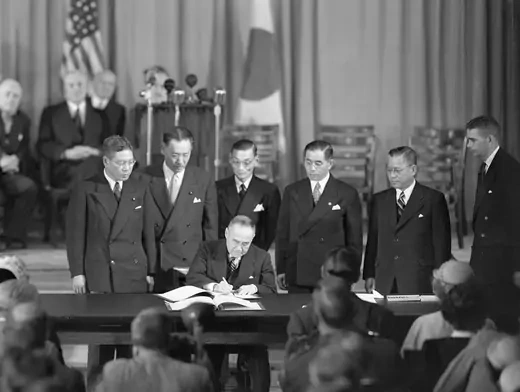
The United States and forty-seven other nations sign the Treaty of Peace [PDF] with Japan in San Francisco, officially ending World War II. Japan renounces all claims to Korea, Formosa (Taiwan), the Pescadores, and the Spratly Islands in the South China Sea. The Senkaku/Diaoyu Islands are not explicitly mentioned in the treaty, though there is a tacit understanding that Japan will administer them as a part of Okinawa Prefecture. Japan is granted “residual sovereignty”—meaning full sovereignty would eventually be transferred to Japan—over the Ryukyu Islands; in turn, the United States is permitted to open military bases on Okinawa. Whether the Senkaku/Diaoyu Islands were considered part of Okinawa or ceded to Taiwan after the treaty remains a contentious issue in the present-day debate over sovereignty in the East China Sea.
U.S.-Japan Security Treaty
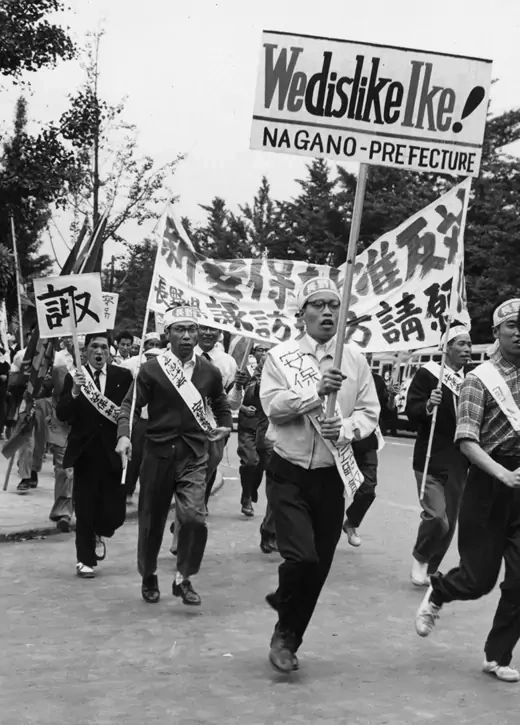
The United States and Japan sign the bilateral Treaty of Mutual Cooperation and Security, a ten-year, renewable agreement stipulating that any attack on territories under Japan’s administration would require action by both countries to “meet the common danger.” (In an analogous situation, the United States is bound by a 1951 mutual defense treaty with the Philippines.) Washington has consistently asserted that the treaty covers the Senkaku/Diaoyu Islands, though it has refrained from explicitly endorsing Japan’s sovereignty claim over the islands. Some analysts believe the U.S.-Japan treaty presents the biggest deterrent to a takeover of the islands by force.
UN Report Finds High Probability of Oil in East China Sea
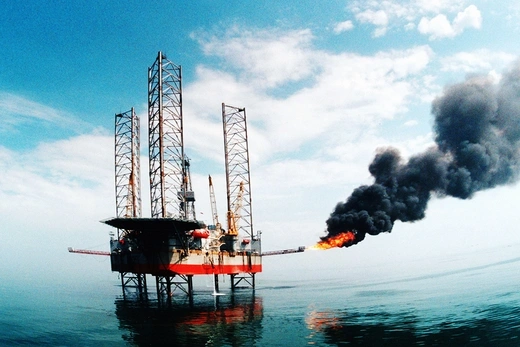
After extensive geological surveys in 1968 and 1969, a report published by the UN Economic Commission for Asia and the Far East finds “substantial energy deposits” in the seabed between Taiwan and Japan—the waters off the Senkaku/Diaoyu Islands. The paper marks one of the first credible findings of hydrocarbon resources there, reigniting interest in the region. Although China has not previously disputed Japanese claims to the islands, it asserts its own sovereignty over them in May 1970, after Japan, South Korea, and Taiwan hold talks on joint energy exploration in the East China Sea.
Okinawa Reversion Treaty
The United States and Japan sign the Okinawa Reversion Treaty, in which Washington effectively returns full control of the Ryukyu Islands to Japan. The move is seen as reinforcing the U.S.-Japan security alliance, which U.S. President Richard Nixon considered to be the “linchpin” for peace in the Pacific. The boundaries set by the agreement [PDF] appear to include the Senkaku/Diaoyu Islands since there was an understanding within the U.S. government that the territories were administered as parts of Okinawa. But the Nixon administration takes a neutral stance on their sovereignty; its priorities are retaining bases in Okinawa and normalizing relations with the PRC, which it hopes will help end the Vietnam War. In response to the reversion treaty, the ROC and PRC begin issuing claims to the islands, saying they have belonged to the Chinese since ancient times and have been administered by the province of Taiwan. Meanwhile, Japan views the reversion agreement with the United States as further validation of its sovereignty over the disputed islands.
Japan and China Normalize Relations
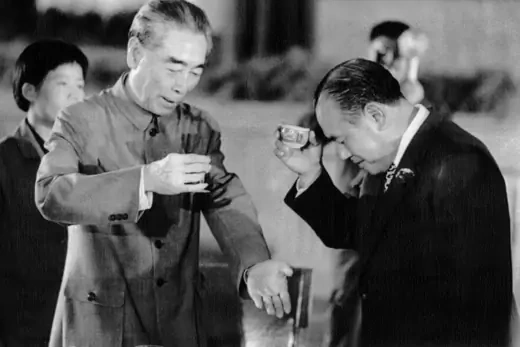
China and Japan formally reestablish diplomatic relations after gradually rebuilding economic ties. In China, the failure of Mao’s Great Leap Forward (1958–1962) preceding the Cultural Revolution resulted in mass starvation that forced Beijing to reevaluate its domestic policies and look to Japan for aid. The Sino-Japanese reconciliation dovetails the rapprochement between the United States and China—a change in official political allegiance from Taipei to Beijing that is a crucial factor in the establishment of diplomatic ties between Japan and China. Nixon, whose administration has made normalizing relations with the PRC a diplomatic priority, visits Beijing the same year, establishing de facto relations with the country after U.S. Secretary of State Henry Kissinger’s visit in July 1971. Trade between Japan and China surges in the period after normalization, deescalating the first round of the Senkaku/Diaoyu Islands disputes.
China Claims Paracel Islands
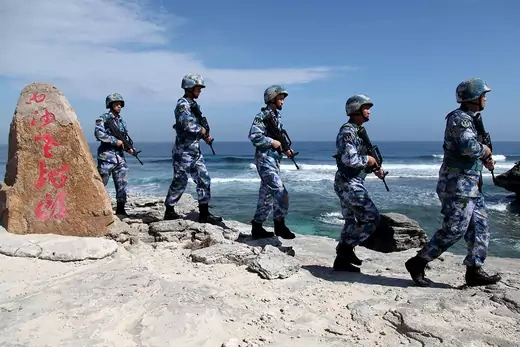
A year after the Paris Peace Accords, which end U.S. involvement in the Vietnam War, Chinese forces occupy [PDF] the western portion of the Paracel Islands, planting flags on several islands and seizing a South Vietnamese garrison. Vietnamese troops flee south and establish the first permanent Vietnamese occupation of the Spratly Islands. Meanwhile, Beijing builds a military installation, including an airfield and artificial harbor, on Woody Island, the largest of the Paracels. After the fall of Saigon and the reunification of Vietnam, the newly formed Socialist Republic of Vietnam upholds the South’s former claims to the Spratlys and Paracels. To this day, China maintains around one thousand troops in the Paracels.
Philippines Discovers Oil Field
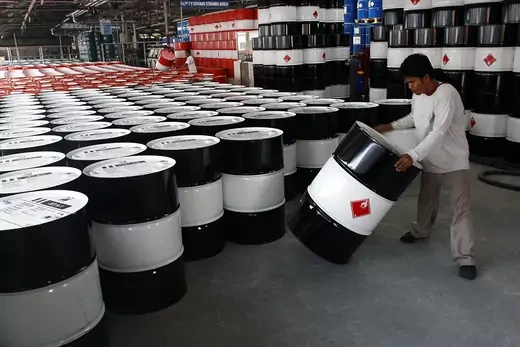
After an extensive exploration program, the Philippines finds the Nido oil field off the coast of Palawan Island, marking the first oil discovery in the Northwest Palawan Basin. The discovery comes four years after the government passes the Oil Exploration and Development Act of 1972, which provides the legal basis for exploring and developing petroleum resources as Manila pushes for energy independence. Philippine Cities Service, Inc., the country’s first oil company, begins drilling a well in the Nido oil field and launches commercial production in 1979, yielding 8.8 million barrels that year. In 2012, the IMF notes [PDF] that the Philippines’ petroleum industry may have “significant potential” in the South China Sea, which is adjacent to the Northwest Palawan Basin.
Sino-Vietnamese War
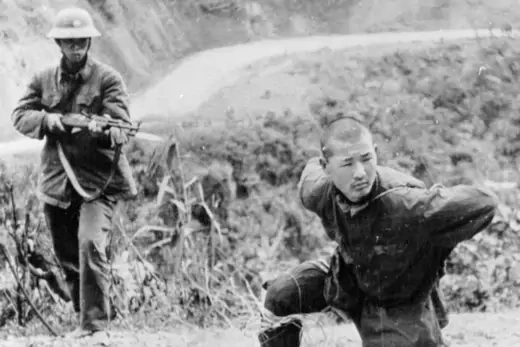
China wages a short but bloody war with Vietnam, launching an offensive in response to Vietnam’s invasion and occupation of Cambodia in 1978, which ended the reign of the communist, Chinese-backed Khmer Rouge. The conflict marks the apex of tensions between Beijing and Hanoi, which were already running high after Vietnam established ties with the Soviet Union, China’s Cold War rival, the previous November. China had aided Vietnam in its wars against both France and the United States. Although both sides claim victory, China withdraws from Vietnam after less than a month, having failed to coerce Vietnam to leave Cambodia. Roughly thirty thousand are killed in the short-lived conflict, which marks the beginning of many border disputes between Beijing and Hanoi and bolsters Vietnam’s lingering distrust of China.
UNCLOS Is Established
After three decades of negotiations, the third and final United Nations Conference on the Law of the Sea, or UNCLOS, culminates in a resolution that defines the rights and responsibilities of nations in their use of surrounding waters based on exclusive economic zones and continental shelves. The measure comes into force on November 14, 1994, a year after Guyana becomes the sixtieth nation to sign the treaty. UNCLOS does not address sovereignty issues related to the South and East China Seas, and its vague wording has prevented it from serving as a credible body of law in resolving territorial disputes. Although the United States recognizes UNCLOS as customary international law, it has yet to ratify the treaty—a move that would give Washington a greater platform from which it could advance its economic and strategic interests.
China Sinks Three Vietnamese Ships
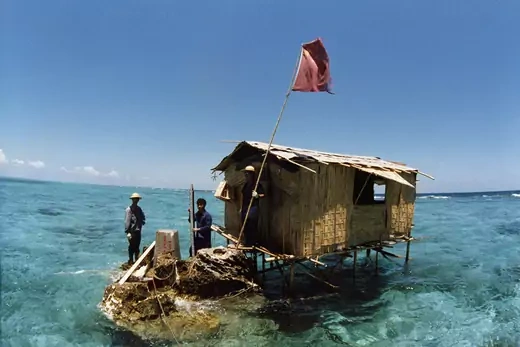
After roughly a decade of relative calm in the South China Sea, China and Vietnam clash on the Johnson Reef, marking China’s first armed conflict over the Spratly archipelago. The Chinese navy sinks three Vietnamese vessels, killing seventy-four sailors in one of the most serious military confrontations in the South China Sea. The incident occurs after Beijing, pursuing a more assertive stance in the area, establishes a physical presence on Fiery Cross Reef in the Spratlys in January 1987. In response, Vietnam occupies several reefs to monitor China’s moves. The incident unfolds amid Deng Xiaoping’s economic reforms of the 1980s, when Chinese economic activity begins shifting to the coastal provinces, and maritime resources become increasingly prized as hydrocarbons are needed to sustain growth.
China Passes Law on the Territorial Sea
China passes the Law on the Territorial Sea and the Contiguous Zone, which lays claim to the entire South China Sea based on its historical right to the area dating from the Western Han dynasty, which ruled between two hundred BCE to nine CE. The law employs more generous methods of territorial determination that would not necessarily be recognized [PDF] and justified by UNCLOS, signed a decade earlier. The move is seen by some as a bid by China to obtain greater maritime security for itself, as Beijing was one of the most active countries at UNCLOS in attempting to obstruct the United States and Soviet Union’s efforts to secure freedom of navigation for warships.
Mischief Reef Incident
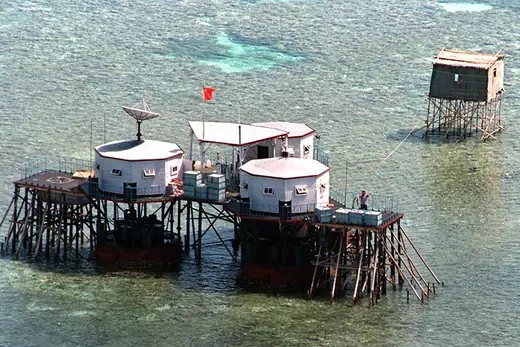
Three Chinese naval vessels fight a ninety-minute battle with a Philippine navy gunboat near Capones Island in the Mischief Reef, part of the Spratly chain of islands claimed by Manila. The incident marks the first time China engages in military confrontation with an ASEAN member other than Vietnam. The clash, which triggers a crisis in Sino-Philippine relations, revives U.S.-Philippine military ties; soon after the incident, U.S. Navy SEALs conduct a joint exercise with their Philippine counterparts on Palawan Island, although Philippine President Fidel Ramos denies that this is connected to Manila’s row with Beijing. Tensions over the occupation subside by midyear, when the Philippines and China sign a nonbinding code of conduct that calls for a peaceful resolution to the territorial dispute and the promotion of confidence-building measures.
China-U.S. Military Agreement
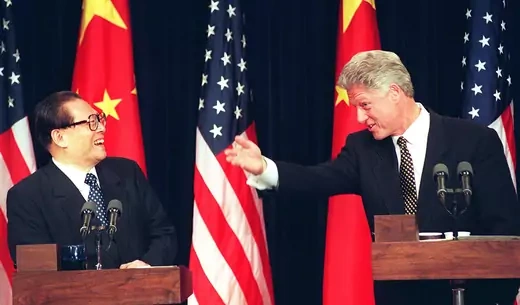
China and the United States sign the Military Maritime Consultative Agreement [PDF], the first bilateral military agreement between the two countries, which serves as a confidence-building measure after a period of frozen relations following the 1989 Tiananmen Square protests. From the mid-to-late 1990s, the Clinton administration works toward security engagement with Beijing as China’s People’s Liberation Army Navy (PLAN) begins to shift from being a mostly coastal defense force to operating a blue-water fleet beyond Chinese territorial waters. The accord aims to promote defense dialogue between naval forces to prevent misunderstandings. However, its efficacy is questioned in April 2001, when a Chinese F-8 interceptor and a U.S. Navy surveillance aircraft collide over the South China Sea, killing a Chinese pilot.
ASEAN and China Code of Conduct
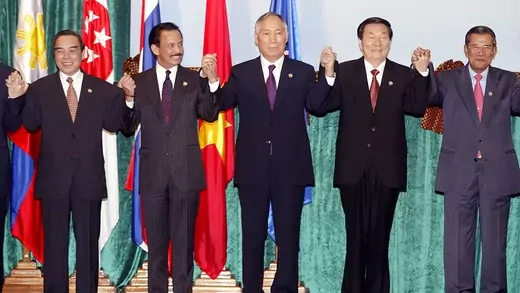
China and the ten ASEAN states reach an agreement in Phnom Penh on the ASEAN-China Declaration on the Conduct of Parties in the South China Sea [PDF], a code of conduct that seeks to ease tensions and creates guidelines for conflict resolution. The agreement comes after six years of negotiations. Beijing had previously insisted on bilateral negotiations with claimants; China’s signing marks the first time it accepts a multilateral approach to the issue. Though the declaration falls short of a binding code of conduct, as the Philippines had sought, it signals China’s recognition that such an agreement could work in its favor by limiting the risk of conflict in the area, which could involve the United States in the dispute.
China, Japan Sign Joint Energy Accord
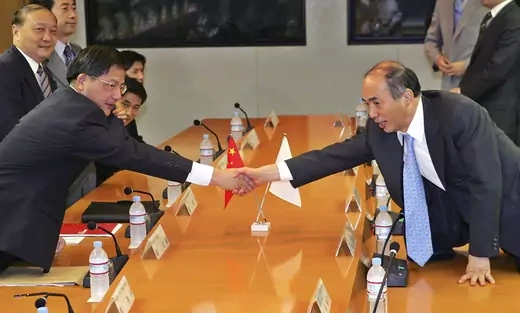
After years of dispute over gas fields in the East China Sea, Japan and China sign a Joint Energy Development Agreement that includes the potentially gas-rich Chunxiao/Shirakaba field. The two countries agree to explore four fields jointly, halt development in contested waters, and collaborate on joint surveys and investment. While the accord is hailed as a major step toward maritime cooperation on energy resources—a strategic priority for both countries—China soon begins to develop the Tianwaitian/Kashi field unilaterally in 2009, stirring protest from Japan. A year later, Japan threatens to bring China to the International Tribunal for the Law of the Sea if China begins producing from the Chunxiao/Shirakaba field. Despite the milestone agreement, little has been done since then to increase joint resource development.
Malaysia, Vietnam Submit UN Claims
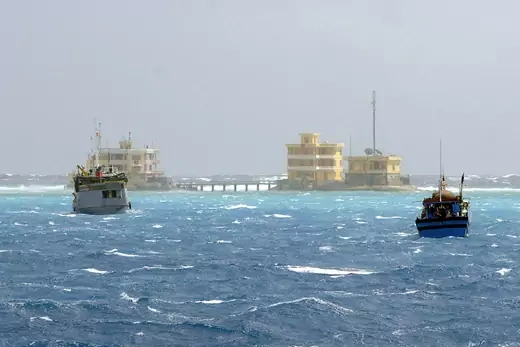
Malaysia and Vietnam file a joint submission to the UN Commission on the Limits of the Continental Shelf to extend their continental shelves beyond the standard two hundred nautical miles from their coastlines, renewing friction over maritime sovereignty in the South China Sea. China views this as a challenge [PDF] to its territorial claims and objects to the submission, saying it “has seriously infringed” on China’s “indisputable sovereignty” over the islands in the South China Sea. Vietnam’s claims are viewed as part of a campaign to bring the South China Sea issue to an international forum, beginning with a conference held in November 2009 in Hanoi.
China Becomes World’s Biggest Energy Consumer
The International Energy Agency reports that China has surpassed the United States as the largest consumer of energy worldwide, consuming roughly 2.3 billion tons of total energy in 2009, approximately 4 percent more than the United States. China also becomes the second-largest consumer and net importer of oil, heightening the strategic importance of trade routes in the East and South China Seas for tanker shipments. The United States had been the world’s largest energy consumer since the early 1990s.
United States Affirms Interest in South China Sea
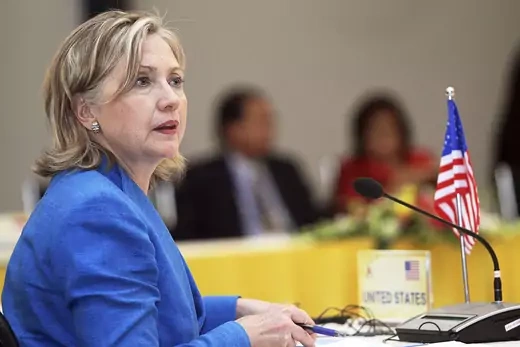
U.S. Secretary of State Hillary Clinton reiterates Washington’s neutrality on sovereignty in the South China Sea in a speech at an Asian regional security meeting in Hanoi, but affirms American interests in the “open access to Asia’s maritime commons.” The speech represents a rebuke to China, which had insisted on its rights to the islands and a bilateral approach to resolving disputes. It also comes at a time when military-to-military talks between Beijing and Washington are suspended and diplomatic relations are at a nadir, with China rescinding an invitation to host former U.S. Secretary of Defense Robert Gates in June and Chinese officials announcing in March that they would not tolerate outside interference. Clinton’s comments are viewed as an expansion of U.S. involvement in the disputes and a boon to Vietnam, which had been attempting to internationalize the conflict in hopes of a resolution.
Chinese Boat Clashes With Japanese Coast Guard
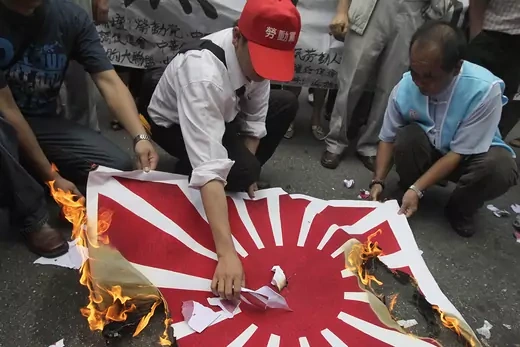
A Chinese fishing boat collides with two Japanese Coast Guard vessels near the Senkaku/Diaoyu Islands, prompting Japan to arrest the crew. Beijing protests the move, enforcing an unofficial embargo on rare earth minerals and arresting four Japanese businessmen for trespassing on a Chinese military facility. China also refuses a meeting between Premier Wen Jiabao and Japanese Prime Minister Naoto Kan at the UN General Assembly. After two weeks of escalating tension, the two countries agree to release their respective citizens. Diplomatic relations finally thaw when Japan’s prime minister and China’s premier meet “coincidentally” on the sidelines of the Asia-Europe Meeting Summit in Brussels in October, 2010. The incident underscores the fragility of the management of the territorial dispute, and sparks debate over Japan’s ability to defend its interests in the face of China’s rise.
Philippines Summons Chinese Envoy
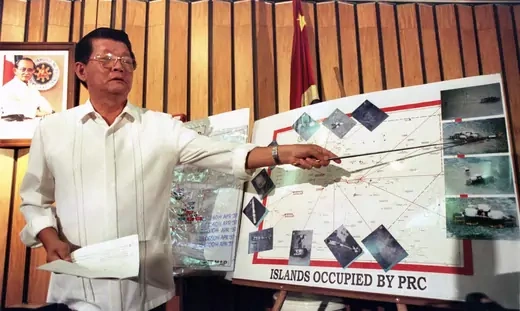
The Philippines summons a Chinese envoy to express its mounting concern about naval incursions in its claimed territory after recording at least five incursions by Chinese ships in the past year near the Spratly Islands and the Amy Douglas Bank, off the coast of Palawan Island. These incursions begin in early March, when Chinese surveillance ships force a Philippine vessel conducting surveys in the Reed Bank to leave the area. Both parties declare the incident as violations of the 2002 ASEAN-China Declaration on the Conduct of Parties in the South China Sea, and the event sets off a series of skirmishes in the region between the two countries. The diplomatic standoff in June comes days after Vietnam protests China’s alleged harassment of its oil exploration ships; Vietnam had been working with multinational corporations, including ExxonMobil and Chevron, to develop hydrocarbon assets.
Philippines Renames South China Sea
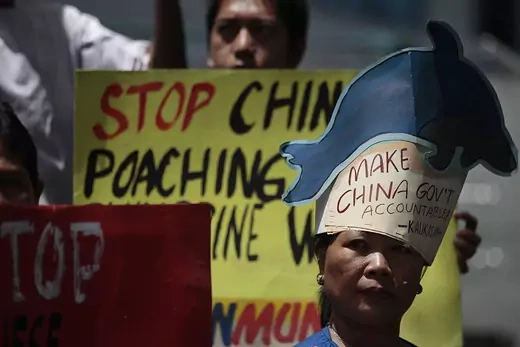
In response to a spate of skirmishes with Chinese vessels, the Philippine government begins referring to the South China Sea as the West Philippine Sea in all official communications and in October 2012 signs an administrative order asserting its “inherent power and right to designate its maritime areas.” U.S. Secretary of State Hillary Clinton also begins referring to the South China Sea as the West Philippine Sea, affirming in a November 2011 joint press conference with her Philippine counterpart the “vigor” of the two countries’ alliance, particularly “at a time when the Philippines is facing challenges to its territorial integrity” in the oceanic region.
Obama Cites U.S. Strategic Rebalancing to Asia-Pacific
U.S. President Barack Obama makes a landmark speech to the Australian parliament, announcing the United States will pivot its strategic attention to the Asia-Pacific, particularly the southern part of the region. The Obama administration announces new troop and equipment deployments to Australia and Singapore and pledges that reductions in defense spending would not come at the expense of commitments to the region. Negotiations continue on the Trans-Pacific Partnership (TPP), a free trade agreement seen as a significant step toward greater U.S. economic integration with the Asia-Pacific. Notably, China is excluded from the talks.
Northeast Asia Leadership Transition
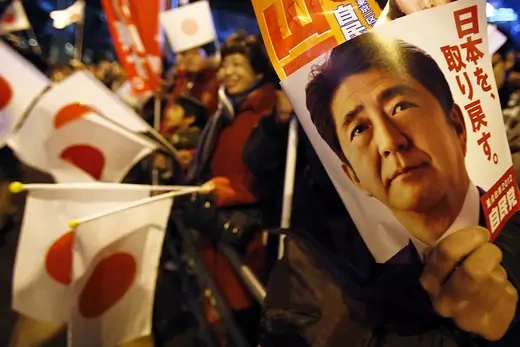
2012 heralds a landmark year for leadership transition in Northeast Asia, raising questions about how territorial disputes will factor into each administration’s agenda. Following a hearty election win, Abe Shinzo takes office as Japan’s prime minister for the second time on December 26. Shortly thereafter he publishes an op-ed in which he warns of the South China Sea transforming into “Lake Beijing,” and proposes a “democratic security diamond” comprising Japan, the United States, India, and Australia that would “safeguard the maritime commons stretching from the Indian Ocean region to the Western Pacific.” China also undergoes its high-profile, once-a-decade leadership transition in November, electing Xi Jinping and Li Keqiang as president and premier, respectively. Its military strategy continues to shift from land-based power to a maritime one, which its new leaders reinforce through an expansion and consolidation of marine agencies as well as rhetoric that refers to maritime rights as part of the country’s “core interests.” South Korea elects Park Geun-hye as its first female president in February 2013 amid heightened tensions over nuclear tests by the North.
Scarborough Shoal Incident
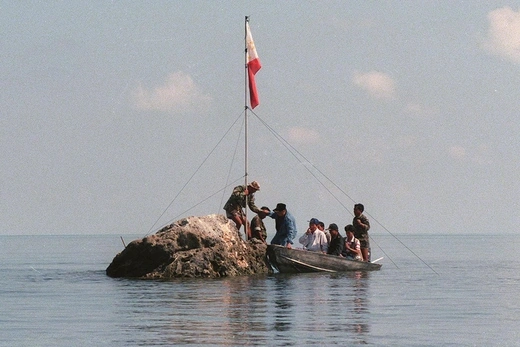
Diplomatic relations between Manila and Beijing decline further after the Philippines dispatches a warship to confront Chinese fishing boats in the Scarborough Shoal, north of the Spratlys. China subsequently dispatches its own surveillance vessels to protect its fishermen and a two-month standoff ensues. As China quarantines some fruits from the Philippines and warns against tourism to the country, regional observers worry that tensions will impede economic relations; Philippine losses in banana exports in May are estimated at $34 million. Bilateral talks stall repeatedly over withdrawal from the shoal, and the Philippine government claims it is pursuing various avenues, including ASEAN involvement, legal options under UNCLOS, and an appeal to the United States for a guarantee of assistance in the case of military confrontation. Beijing maintains regular patrols that prevent Philippine fisherman from accessing these waters.
Vietnam Passes Maritime Law
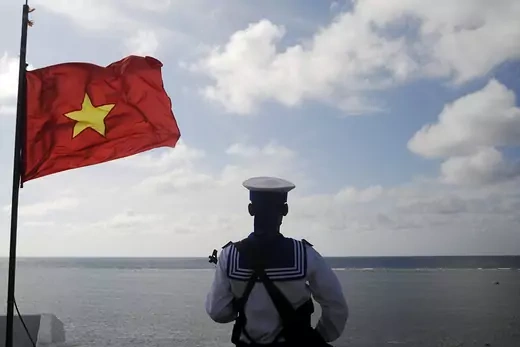
Vietnam passes a maritime law asserting its jurisdiction over the disputed Spratly and Paracel Islands, demanding notification from any foreign naval ships passing through the area. China issues a strong response, announcing the establishment of a city, Sansha, on the Paracels that would administer the Paracels, Spratlys, and Macclesfield Bank. Relations between Hanoi and Beijing had been fluctuating; in May–June 2011, Chinese surveillance ships cut the cables of oil and gas survey vessels operated by Vietnam’s state-owned energy firm, PetroVietnam, but tensions eased the following October after a high-level visit by Vietnam’s general party secretary to Beijing produced a bilateral agreement outlining measures for handling maritime disputes. Hanoi had also been stepping up its defense budget, reportedly increasing it by 70 percent to $2.6 billion in 2011.
ASEAN Fails to Issue Communique
For the first time in its forty-five-year history, ASEAN fails to issue a communiqué at the conclusion of its annual meeting in Cambodia. Its ten members reach an impasse over China’s claims in the South China Sea, and member countries disagree over whether to include the territorial issue in the joint statement. This diplomatic freeze follows a maritime standoff between China and the Philippines in the Scarborough Shoal three months prior, and is widely seen as a failure for the regional body. Some observers view China’s influence on Cambodia, the 2012 rotating chair of the conference, as having caused the exclusion of the Scarborough Shoal and EEZ issues from the text, resulting in the deadlock.
Japan Buys Senkaku/Diaoyu Islands
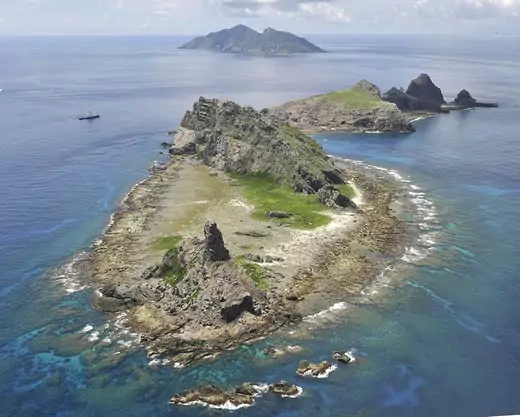
The government of Japanese Prime Minister Yoshihiko Noda signs a contract, worth $26 million, to purchase three of the five disputed Senkaku/Diaoyu Islands from private landowner Kunioki Kurihara. The move comes after Tokyo Governor Shintaro Ishihara announces in April his intention to purchase the islands to protect their sovereignty. Japan defends the decision, saying it was to prevent Kurihara from developing the islands, but the purchase provokes an angry response from China just a month before its November leadership transition. In the subsequent weeks, some of the largest anti-Japanese protests since the countries normalized relations in 1972 erupt across China. Thousands march in more than eighty-five cities. The rupture has economic consequences, with Japanese companies in China reporting significant losses and air travel between the two countries dipping dramatically. IMF Managing Director Christine Lagarde warns that the protests have the potential to harm the global economy, calling the two countries “key economic drivers” and urging them to be “fully engaged.”
China Claims Territorial Sea Baselines
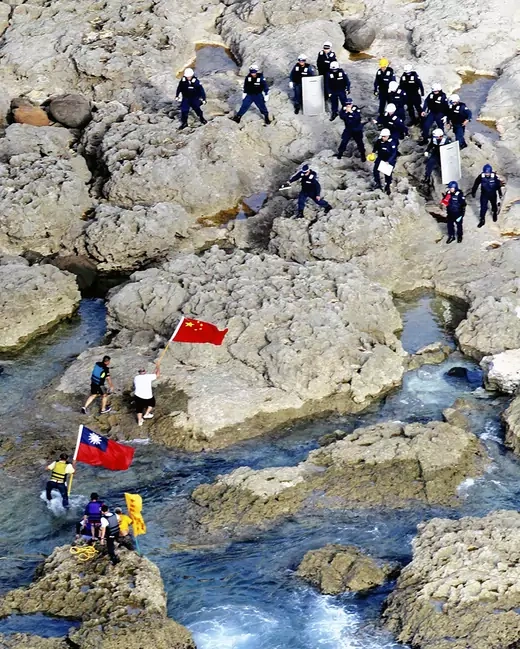
In response to Japan’s nationalization of the Senkaku/Diaoyu Islands, Beijing declares territorial sea baselines around the land, announcing Chinese administration of the disputed islands and directly challenging Tokyo’s control. The move ends what analysts consider the status quo of Japanese administration of the area. As a result, two of China’s maritime agencies gain increased power over the waters and begin to increase their patrol in areas previously dominated by the Japan Coast Guard. In December, China submits to the UN an explanation of its claims to the disputed area in the East China Sea, arguing that “geological characteristics” show a natural prolongation of China’s land territory. U.S. Secretary of State Hillary Clinton urges both sides to let “cool heads” prevail amid the flare-up.
China Launches First Aircraft Carrier
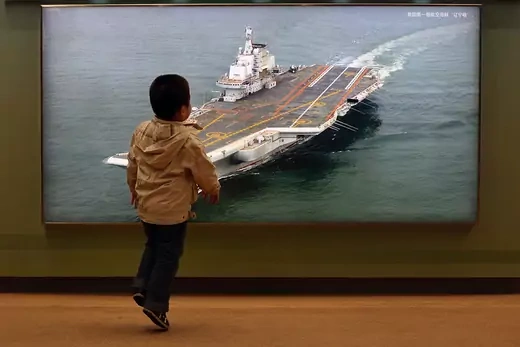
China puts its first aircraft carrier, the Liaoning, into service, saying the vessel will protect national sovereignty, although for the near future it will only be used for training and testing purposes. The public launch comes a month before China’s once-a-decade leadership transition, indicating an effort by the Chinese government to forge national unity ahead of the high-profile event. The aircraft launch also marks a continuation of Beijing’s substantial naval modernization, which a U.S. Congressional report [PDF] notes is of concern, given its venture into the global maritime domain—a sphere long dominated by the U.S. Navy.
Japan Increases Defense Budget
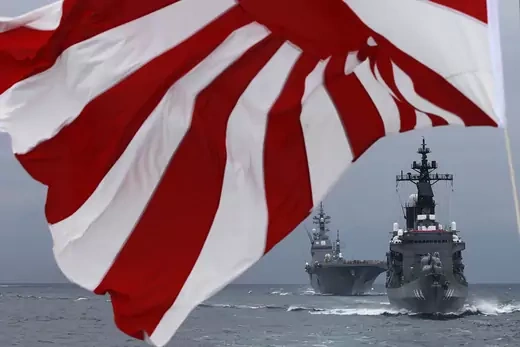
Newly elected Prime Minister Shinzo Abe’s cabinet increases the country’s defense budget for the first time in eleven years, approving a $51.7 billion defense package for 2013, marking a 0.8 percent uptick. The spending increase, in addition to a 1.9 percent hike in the Coast Guard budget, comes as Abe’s administration bolsters Japan’s maritime capabilities and ability to monitor and protect the disputed Senkaku/Diaoyu Islands in the East China Sea. In January, Abe visits Vietnam, Thailand, and Indonesia in a push to boost ties with ASEAN countries.
Philippines Files UN Arbitration Over China’s Sovereignty Claims
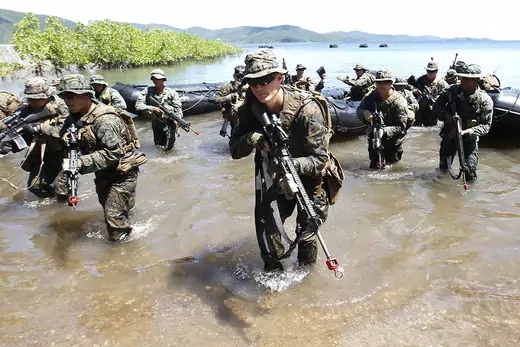
The Philippines initiates an international arbitration case under UNCLOS over Chinese claims of sovereignty to the Spratly Islands and Scarborough Shoal originating from the April 2012 clashes, acting on decades of stalled attempts at resolution. China rejects the process, forcing the court and its arbitration to continue without its participation. The case marks the first time a country has brought a claim against China under UNCLOS regarding the issue.
Japan Offers Military Aid
Japan offers military aid for the first time since the end of World War II, a bid to bolster its Southeast Asian regional alliances vis-à-vis China, providing $2 million for disaster relief training in East Timor and Cambodia, historically an ally of Beijing. As maritime threats from China increase, Japan considers selling military equipment, including seaplanes and, eventually, even shallow-water submarines, indicating a push to raise its influence in the region. In May 2013, Japan announces it will provide patrol boats to the Philippine Coast Guard to boost the country’s capabilities in the South China Sea and counter China’s growing maritime presence in the region. Japan’s outreach marks a visible shift from the nation’s traditionally pacifist foreign and defense policies.
China Declares Air Defense Identification Zone
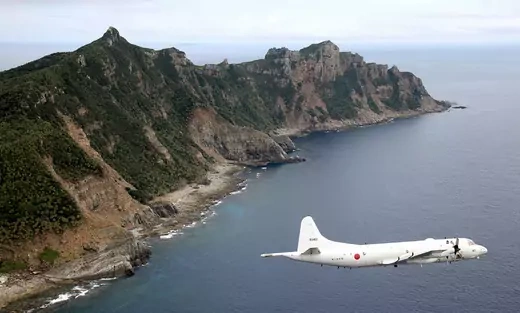
China’s Ministry of Defense announces the creation of an East China Sea Air Defense Identification Zone that requires all non-commercial air traffic to submit flight plans prior to entering the area, which covers most of the East China Sea and includes the Senkaku/Diaoyu Islands. China announces it could take military action against aircraft flying near the islands, elevating the territorial dispute to airspace. U.S. Secretary of State John Kerry immediately issues a statement urging China to “exercise caution and restraint,” while U.S. Secretary of Defense Chuck Hagel reaffirms Washington’s longstanding policy that the U.S.-Japan Mutual Defense Treaty covers the disputed Islands. China and Japan summon each others’ ambassadors to lodge official complaints, while South Korea, the United States, and Japan all respond by sending military aircraft on patrols over the East China Sea.
U.S., Phillippines Sign New Defense Pact
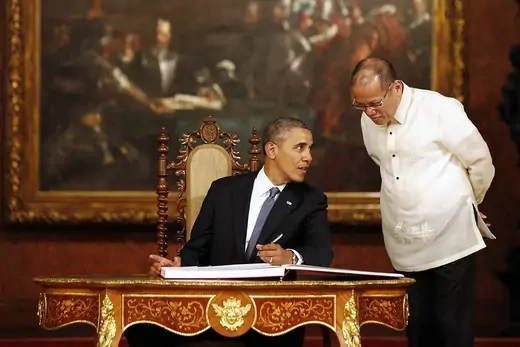
U.S. President Barack Obama, on the last leg of a four-nation Asia tour, signs a new ten-year military pact with the Philippines. Under the Enhanced Defence Cooperation Agreement, the U.S. military would gain increased rotational troop presence in the country, engage in more joint training, and have greater access to bases across the archipelago, including ports and airfields. The deal is the centerpiece of Obama’s first visit to the Philippines, the United States’ oldest ally in the region, and underscores the administration’s commitment to the Asia “pivot.” While Obama expresses solidarity with Manila as it seeks international arbitration over the disputed South China Sea islands, he insists that the deal is not aimed at containing China.
Vietnamese, Chinese Ships Collide After China Moves Oil Rig
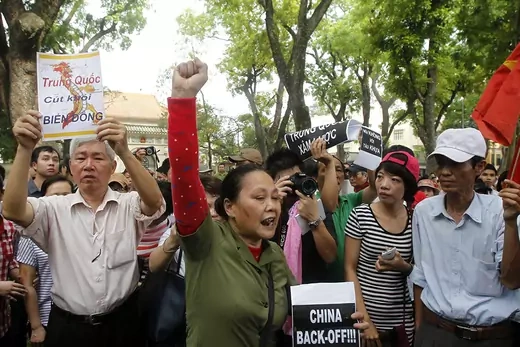
Vietnam dispatches naval vessels in an attempt to stop China from establishing an oil rig in contested waters near the Paracel Islands. The encounter quickly escalates as China sends forty ships to protect the rig, and several vessels collide. Both China and Vietnam claim that the other rammed into their ships. Anti-China protests erupt throughout Vietnam, and rioters vandalize hundreds of businesses thought to be owned by Chinese individuals. On July 15, China’s state-owned oil company announces that it will withdraw the rig a month ahead of schedule.
Xi, Abe Discuss Maritime Dispute
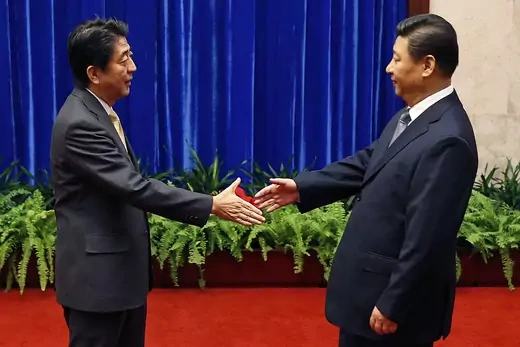
Chinese President Xi Jinping and Japanese Prime Minister Abe Shinzo meet for the first time since both leaders came to power on the sidelines of the 2014 Asia Pacific Economic Cooperation summit in Beijing. Days earlier, China and Japan reach a four-point agreement designed to improve diplomatic and security ties. The agreement also aims to put in place crisis-management mechanisms to prevent conflict escalation over disputed territory in the East China Sea.
U.S. Warship Patrols Near Chinese-Built Islands
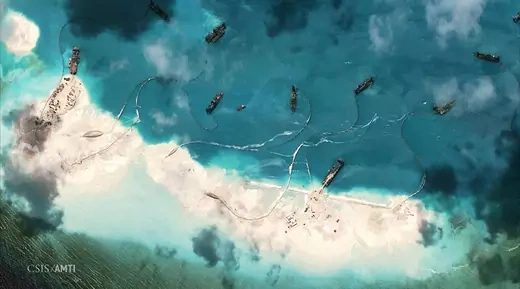
A U.S. Navy patrol sails within twelve nautical miles of Chinese-built islands to assert “freedom of navigation” in disputed waters in the South China Sea. China’s ambassador to the United States calls the patrol a “serious provocation, politically and militarily.” The mission comes after an August 2015 U.S. Department of Defense report says China has reclaimed nearly three thousand acres on islands known as the Spratlys. China’s land reclamation efforts, including infrastructure development, dwarf the one hundred acres built up by other claimants over the last forty-five years. At the annual 2015 Shangri-La Dialogue in Singapore, U.S. Secretary of Defense Ash Carter urges Beijing to cease its building projects, expressing concern over the prospect of further militarization in the South China Sea.
China Deploys Missiles to Paracels
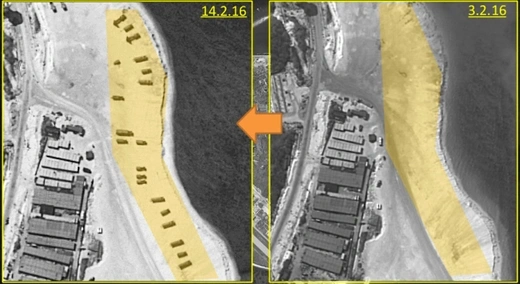
Beijing deploys surface-to-air missiles on Woody Island, a land mass in the Paracel Island chain in the South China Sea, according to U.S. and Taiwanese officials. U.S. and regional officials warn that the deployment may signal a “militarization” of the maritime disputes, while China argues that the installation of missiles falls within its rights for defense on what it considers sovereign territory. Some experts suggest that the move may be a response to U.S. freedom of navigation operations in disputed waters. The People’s Liberation Army air force also stationed J-11 fighter aircraft in the Paracels in October 2015, according to Chinese media reports.
Tribunal Rules Against China’s South China Sea Claims

The Permanent Court of Arbitration in The Hague rules in favor of the Philippines in a case opened in 2013 against the People’s Republic of China. The tribunal finds that China’s declared “nine-dash line” has no legal basis [PDF] for its claims to historic rights to resources in the South China Sea. The court also rules that none of the land features fit requirements under the UN Convention on the Law and the Sea (UNCLOS) to generate a 200-nautical-mile exclusive economic zone for China; many of the features are the result of extensive Chinese land reclamation. The court says Beijing violated its obligations as a member of UNCLOS, saying its island-building activities harmed the marine environment and its vessels’ unsafe practices heightened navigational risks. China’s foreign ministry says it “neither accepts nor recognizes” the court’s award.
Duterte Bans Fishing in Shoal Waters
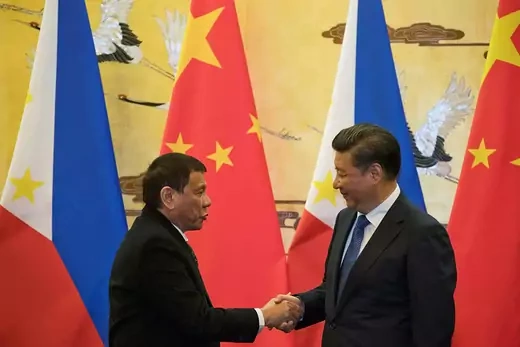
Philippine President Rodrigo Duterte announces the establishment of a no-fishing zone and marine sanctuary at a lagoon in the Scarborough Shoal. The shoal has been a focal point of tensions between the Philippines and China, but Duterte has broken with his predecessor Benigno S. Aquino III’s tough response to China’s actions. Instead, Duterte has signaled a warming of ties between Manila and Beijing, preferring to boost economic links and to resume bilateral dialogue with China on disputed territories. Neither China nor the Philippines has relinquished its respective sovereignty claim, but the leaders of the two countries seem poised to take a more reconciliatory approach.
China Seizes U.S. Underwater Drone
A Chinese warship snatches a U.S. Navy underwater drone that was gathering scientific data in the South China Sea, according to the Pentagon. U.S. officials said the Chinese ship ignored their calls to return the drone and sailed away with it. Days later, China agrees to return the drone, but criticizes the United States for “hyping up” the dispute, while the Pentagon maintains that it was an “unlawful seizure” that should not happen again.
Collision Causes Toxic Oil Spill in East China Sea
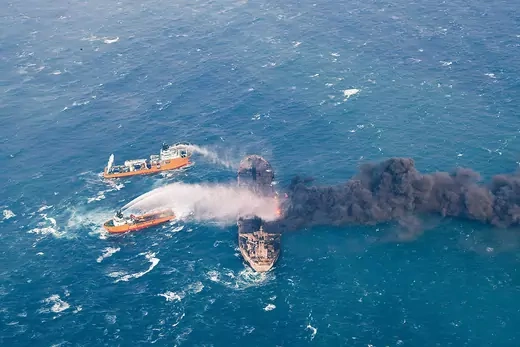
A Panamanian-flagged, Iranian-owned tanker carrying nearly one million barrels of natural-gas condensate collides with the CF Crystal, a Hong Kong–flagged cargo ship carrying grain from the United States in the East China Sea, 160 nautical miles off the coast of Shanghai. The tanker, traveling from Iran to South Korea, catches fire, explodes, and sinks after eight days ablaze, killing all thirty-two crew members and causing a major oil spill of both condensate—ultra-light fuel oil—and fuel. Experts say it is the largest-ever spill of condensate and the slick risks contaminating some of the world’s most abundant fisheries. Seven vessels (five Chinese, one Japanese, and one South Korean) are involved in clean up efforts in the Northeast Asian waters. China, Hong Kong, Iran, and Panama agree to jointly investigate the collision.
Chinese Bomber Lands on Island
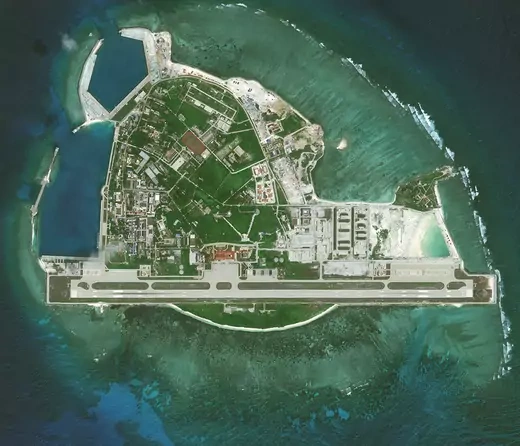
For the first time, a Chinese bomber lands on an island reef in the South China Sea. A video shared by the official People’s Daily shows an H-6 aircraft landing and taking off from Woody Island in the Paracels. Bombers taking off from the island could reach areas throughout the South China Sea, including nearly all of the Philippines, according to expert analysis.
China, Japan Launch Hotline to Avoid Accidents
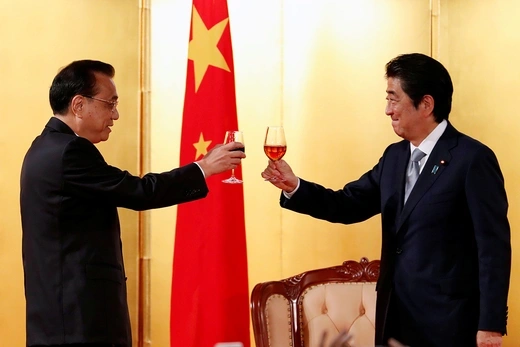
After more than a decade of stalled talks, Japan and China establish a hotline to prevent accidents at sea and in the air. The two countries also agree to hold regular meetings between defense officials, as well as between experts to maintain the communication system.
U.S., Chinese Warships Nearly Collide
A U.S. destroyer narrowly avoids colliding with a Chinese destroyer near the Spratly Islands. The Pentagon says the Chinese ship, the Lanzhou, passed within forty-five yards of the USS Decatur, which was conducting a routine freedom of navigation operation. China condemns the U.S. patrol as a threat to its sovereignty. Days later, U.S. Secretary of Defense Jim Mattis cancels his trip to Beijing, and President Donald J. Trump says President Xi Jinping “may not be a friend of mine anymore.”
Philippine President Alarmed by Chinese Ships
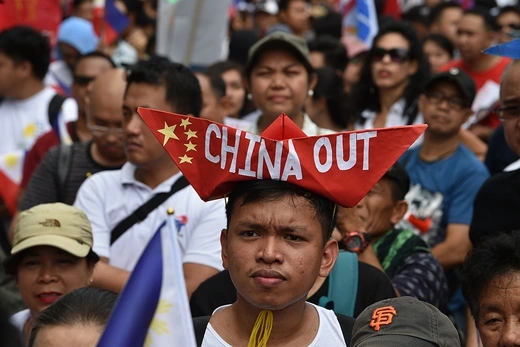
Philippine President Rodrigo Duterte warns he will send troops on a “suicide mission” if China continues to send ships near the Philippines-occupied Thitu Island in the Spratly chain. His threat comes after more than two hundred Chinese ships were seen near the island from January to March. The Philippines had been constructing a beaching ramp on the island, which is also claimed by China, to ease the delivery of construction equipment and supplies.
Chinese Ship Spends Months in Vietnam’s EEZ
A Chinese survey ship, Haiyang Dizhi 8, and escort ships enter Vietnam’s exclusive economic zone (EEZ) near an offshore oil block. In the years leading up to it, China tries to prevent Vietnam from drilling in the region through ship patrols and aggressive maritime maneuvers. Vietnamese officials demand that China remove the ships, and in August people protest outside the Chinese embassy in Hanoi, but Haiyang Dizhi 8 doesn’t leave until October.
Tensions Rise in South China Sea Amid Pandemic
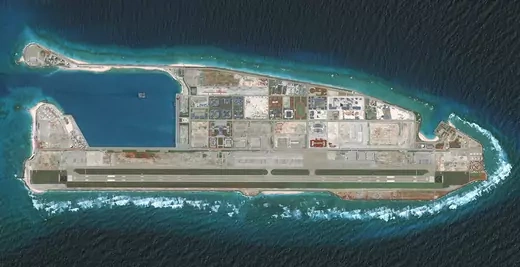
China more aggressively asserts its claims in the South China Sea as countries in the region battle the coronavirus pandemic. In February, a Chinese naval ship reportedly aims its weapons control system at a Philippine naval ship in the Spratly Islands. The next month, China opens new research stations, which include defense silos and military-grade runways, on the Fiery Cross and Subi Reefs. In April, Vietnam lodges a formal complaint over China’s actions after a Chinese vessel rams and sinks a Vietnamese fishing boat near the Paracels. Soon after, Beijing establishes two administrative districts that cover the Paracel and Spratly Islands; the Philippines and Vietnam denounce the move.
Chinese and Philippine Navies Face Off
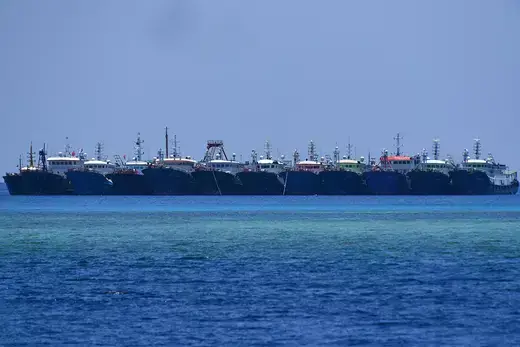
China steps up its intimidation tactics in the wake of President Duterte’s hardening support for the 2016 Hague ruling that rejected the nine-dash line, a legal decision also endorsed by France, Germany, and the United Kingdom. In March 2021, China deploys two hundred ships to Whitsun Reef, part of the Philippines’ exclusive economic zone (EEZ). While Beijing claims that the ships are a “fishing fleet,” Manila says they appear to be operated by military personnel. In November 2022, with U.S. Vice President Kamala Harris visiting the Philippines, that country’s navy accuses China’s coast guard of seizing debris from a suspected Chinese rocket that landed in Philippine waters.
Indonesia and Vietnam Finalize EEZ
After twelve years of negotiation, Indonesia and Vietnam announce the finalized boundaries of their respective EEZs. Analysts say the step removes a major irritant in the countries’ bilateral relations. Previously, they had overlapping EEZ claims to the Natuna islands in the South China Sea, around two hundred nautical miles from Indonesia’s shores, that led to tensions over fishing and navigation rights. Significantly, both Vietnam’s and Indonesia’s EEZ borders partially overlap with China’s nine-dash line, representing a challenge to Beijing’s territorial claims.
Philippines Welcomes Expanded U.S. Military Presence

Less than a year after taking office, Philippine President Ferdinand Marcos Jr. welcomes an expanded U.S. military presence on the island nation. The four additional military bases in the northern Philippines will more than double the previous number, expanding the United States’ presence in the South China Sea. Chinese officials raise strenuous objections to the move while Philippine diplomats confront their Chinese counterparts over accusations that China’s navy has repeatedly used lasers to harass Philippine and Australian sailors. The following month, as President Xi begins an unprecedented third term as China’s leader, Beijing announces a 7.2 percent increase in military spending, citing “escalating” threats.
US-Japan-South Korea Summit Shows United Front
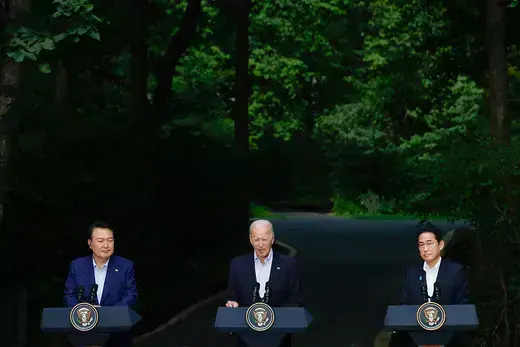
President Biden hosts Japanese Prime Minister Kishida Fumio and South Korean President Yoon Suk Yeol for a first-ever trilateral summit at the Camp David presidential retreat outside of Washington, DC. The summit reaffirms the three countries’ mutual cooperation in the Indo-Pacific: their public statement condemns China’s aggressive behavior and reiterates their commitment to The Hague’s 2016 ruling against China’s nine-dash line. The meeting comes two months after Biden and Indian Prime Minister Narendra Modi jointly commit to upholding the UNCLOS decision and other international law in the South China Sea, a move that some experts say signals New Delhi’s rising discomfort with Beijing’s maritime expansionism.
China’s Expanded Maritime Map Draws Protest
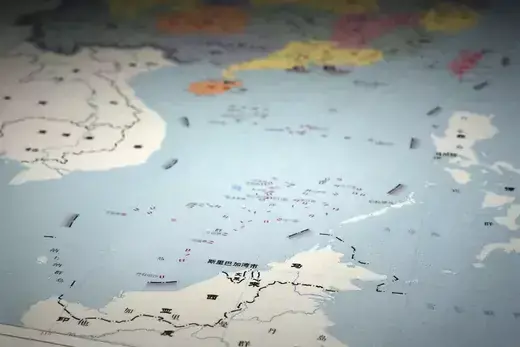
China releases an updated version of its official territorial map, which includes an extra dash added to the previous nine-dash line. The new “ten-dash” map includes the island of Taiwan and most of the Spratly Islands, in violation of the UNCLOS determination. The new map prompts a swift rejection by ASEAN members Indonesia, Malaysia, the Philippines, and Vietnam. India, Japan, and Taiwan also voice their displeasure.
Summit of U.S., Japan, and the Philippines Reaffirms Maritime Cooperation

The trilateral summit comes days after U.S., Australian, Japanese, and Philippine forces conducted their first-ever four-way joint naval patrols in the Philippines’ EEZ. In their leaders’ statement, they highlight China’s recent aggressive moves in the South China Sea and express concern with its increased patrolling in the East China Sea, where the Japan-administered Senkaku/Diaoyu Islands are located. On April 28, China’s Coast Guard confronts Japanese lawmakers conducting an inspection mission in the East China Sea.
Collisions Escalate China-Philippines Dispute Over Second Thomas Shoal

A confrontation between the Chinese coast guards and a Philippine supply ship flares up near the Second Thomas Shoal. The shoal is an atoll within the Philippines’ two-hundred-mile Exclusive Economic Zone, but China claims the area is part of its territorial waters. In what is considered the most violent clash between the two yet, the Philippines accuses Chinese forces of repeatedly ramming into Philippine navy boats and threatening their crew with armed personnel.
The U.S. State Department reaffirms its mutual defense treaty with the Philippines, calling China’s actions “escalatory and irresponsible.” In July, Beijing and Manila reach a “provisional agreement” to reduce clashes in the South China Sea, including by establishing a communications hotline to try to prevent future conflict. However, both sides seem to have differing interpretations of the agreement.
 Online Store
Online Store
